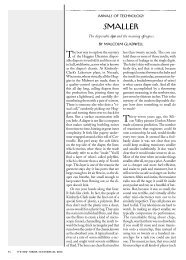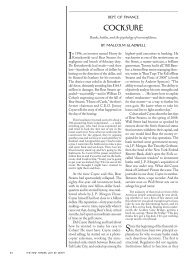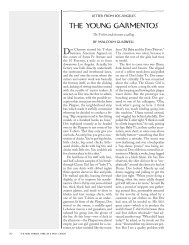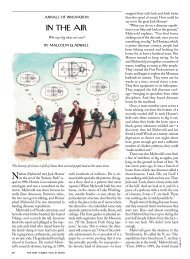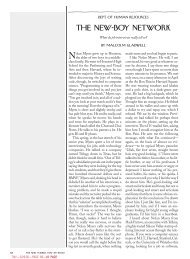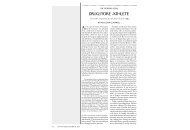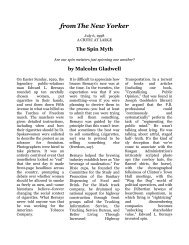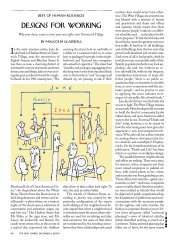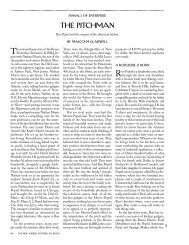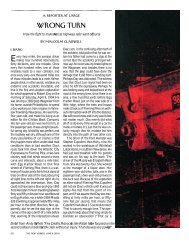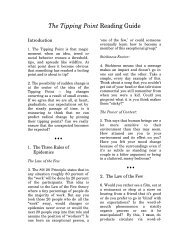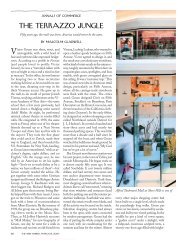from The New Yorker - Malcolm Gladwell
from The New Yorker - Malcolm Gladwell
from The New Yorker - Malcolm Gladwell
You also want an ePaper? Increase the reach of your titles
YUMPU automatically turns print PDFs into web optimized ePapers that Google loves.
1.<br />
Steve Gundrum launched<br />
Project Delta at a small<br />
dinner last fall at Il Fornaio,<br />
in Burlingame, just down<br />
the road <strong>from</strong> the San<br />
Francisco Airport. It wasn't<br />
the Þrst time he'd been to Il<br />
Fornaio, and he made his<br />
selection quickly, with just a<br />
glance at the menu; he is the<br />
sort of person who might<br />
have thought about his<br />
choice in advance -- maybe<br />
even that morning, while<br />
shaving. He would have<br />
posed it to himself as a<br />
question -- Ravioli alla<br />
Lucana? -- and turned it<br />
over in his mind, assembling<br />
and disassembling the dish,<br />
ingredient by ingredient, as<br />
if it were a model airplane.<br />
Did the Pecorino pepato<br />
really belong? What if you<br />
dropped the basil? What<br />
would the ravioli taste like if<br />
you froze it, along with the<br />
ricotta and the Parmesan,<br />
and tried to sell it in the<br />
supermarket? And then<br />
what would you do about the<br />
fennel?<br />
<strong>from</strong> <strong>The</strong> <strong>New</strong> <strong>Yorker</strong><br />
September 5, 2005<br />
ANNALS OF TECHNOLOGY<br />
<strong>The</strong> Bakeoff<br />
Project Delta aims to create the perfect cookie<br />
by <strong>Malcolm</strong> <strong>Gladwell</strong><br />
Gundrum is short and round.<br />
He has dark hair and a<br />
mustache and speaks with the<br />
flattened vowels of the upper<br />
Midwest. He is voluble and<br />
excitable and doggedly<br />
unpretentious, to the point<br />
that your best chance of<br />
seeing him in a suit is<br />
probably Halloween. He runs<br />
Mattson, one of the country's<br />
foremost food research-anddevelopment<br />
firms, which is<br />
situated in a low-slung<br />
concrete-and-glass building in<br />
a nondescript office park in<br />
Silicon Valley. Gundrum's<br />
office is a spare, windowless<br />
room near the rear, and all<br />
day long white-coated<br />
technicians come to him with<br />
prototypes in little bowls, or<br />
on skewers, or in Tupperware<br />
containers. His job is to taste<br />
and advise, and the most<br />
common words out of his<br />
mouth are "I have an idea."<br />
Just that afternoon, Gundrum<br />
had ruled on the<br />
reformulation of a popular<br />
spinach dip (which had an<br />
unfortunate tendency to smell<br />
like lawn clippings) and<br />
examined the latest iteration<br />
of a low-carb kettle corn for<br />
evidence of rhythmic<br />
munching (the metronomic<br />
hand-to-mouth cycle that<br />
lies at the heart of any<br />
successful snack<br />
experience). Mattson<br />
created the shelf-stable Mrs.<br />
Fields Chocolate Chip<br />
Cookie, the new Boca Burger<br />
products for Kraft Foods,<br />
Orville Redenbacher's<br />
Butter Toffee Popcorn<br />
Clusters, and so many other<br />
products that it is<br />
impossible to walk down the<br />
aisle of a supermarket and<br />
not be surrounded by<br />
evidence of the company's<br />
handiwork.<br />
That evening, Gundrum had<br />
invited two of his senior<br />
colleagues at Mattson --<br />
Samson Hsia and Carol<br />
Borba -- to dinner, along<br />
with Steven Addis, who runs<br />
a prominent branding firm<br />
in the Bay Area. <strong>The</strong>y sat<br />
around an oblong table off<br />
to one side of the dining<br />
room, with the sun<br />
streaming in the window,<br />
and Gundrum informed<br />
them that he intended to<br />
reinvent the cookie, to make
something both nutritious<br />
and as "indulgent" as the<br />
premium cookies on the<br />
supermarket shelf. "We<br />
want to delight people," he<br />
said. "We don't want some<br />
ultra-high-nutrition power<br />
bar, where you have to<br />
rationalize your<br />
consumption." He said it<br />
again: "We want to delight<br />
people."<br />
As everyone at the table<br />
knew, a healthful, goodtasting<br />
cookie is something<br />
of a contradiction. A cookie<br />
represents the combination<br />
of three unhealthful<br />
ingredients-sugar, white<br />
flour, and shortening. <strong>The</strong><br />
sugar adds sweetness, bulk,<br />
and texture: along with<br />
baking powder, it produces<br />
the tiny cell structures that<br />
make baked goods light and<br />
fluffy. <strong>The</strong> fat helps carry the<br />
flavor. If you want a big hit<br />
of vanilla, or that chocolate<br />
taste that really blooms in<br />
the nasal cavities, you need<br />
fat. It also keeps the strands<br />
of gluten in the flour <strong>from</strong><br />
getting too tightly bound<br />
together, so that the cookie<br />
stays chewable. <strong>The</strong> ¦our, of<br />
course, gives the batter its<br />
structure, and, with the<br />
sugar, provides the base for<br />
the browning reaction that<br />
occurs during baking. You<br />
could replace the standard<br />
white flour with wheat flour,<br />
which is higher in fibre, but<br />
fibre adds grittiness. Over<br />
the years, there have been<br />
many attempts to resolve<br />
these contradictions -- <strong>from</strong><br />
Snackwells and diet Oreos to<br />
the dry, grainy hockey pucks<br />
that pass for cookies in<br />
health-food stores -- but in<br />
every case ¦flavor or fluffiness<br />
or tenderness has been<br />
compromised. Steve<br />
Gundrum was undeterred. He<br />
told his colleagues that he<br />
wanted Project Delta to create<br />
the world's great-est cookie.<br />
He wanted to do it in six<br />
months. He wanted to enlist<br />
the biggest players in the<br />
American food industry. And<br />
how would he come up with<br />
this wonder cookie? <strong>The</strong> oldfashioned<br />
way. He wanted to<br />
hold a bakeoff.<br />
2.<br />
<strong>The</strong> standard protocol for<br />
inventing something in the<br />
food industry is called the<br />
matrix model. <strong>The</strong>re is a<br />
department for product<br />
development, which comes up<br />
with a new idea, and a<br />
department for process<br />
development, which figures<br />
out how to realize it, and then,<br />
down the line, departments<br />
for packing, quality assurance,<br />
regulatory affairs, chemistry,<br />
microbiology, and so on. In a<br />
conventional bakeoff,<br />
Gundrum would have pitted<br />
three identical matrixes<br />
against one another and<br />
compared the results. But he<br />
wasn't satisfied with the<br />
unexamined assumption<br />
behind the conventional<br />
bakeoff -- that there was just<br />
one way of inventing<br />
something new.<br />
Gundrum had a particular<br />
interest, as it happened, in<br />
software. He had read<br />
widely about it, and once,<br />
when he ran into Steve Jobs<br />
at an Apple store in the<br />
Valley, chatted with him for<br />
forty-five minutes on<br />
technical matters relating to<br />
the Apple operating system.<br />
He saw little difference<br />
between what he did for a<br />
living and what the software<br />
engineers in the<br />
surrounding hills of Silicon<br />
Valley did. "Lines of code<br />
are no different <strong>from</strong> a<br />
recipe," he explains. "It's the<br />
same thing. You add a little<br />
salt, and it tastes better. You<br />
write a little piece of code,<br />
and it makes the software<br />
work faster." But in the<br />
software world, Gundrum<br />
knew, there were ongoing<br />
debates about the best way<br />
to come up with new code.<br />
On the one hand, there was<br />
the "open source"<br />
movement. Its patron saint<br />
was Linus Torvald, the<br />
Norwegian hacker who<br />
decided to build a free<br />
version of Unix, the hugely<br />
complicated operating<br />
system that runs many of<br />
the world's large computers.<br />
Torvald created the basic<br />
implementation of his<br />
version, which he called<br />
Linux, posted it online, and<br />
invited people to contribute<br />
to its development. Over the
years, thousands of<br />
programmers had helped,<br />
and Linux was now<br />
considered as good as<br />
proprietary versions of Unix.<br />
"Given enough eyeballs all<br />
bugs are shallow" was the<br />
Linux mantra: a thousand<br />
people working for an hour<br />
each can do a better job<br />
writing and fixing code than<br />
a single person working for a<br />
thou-sand hours, because<br />
the chances are that among<br />
those thousand people you<br />
can find precisely the right<br />
expert for every problem<br />
that comes up.<br />
On the other hand, there<br />
was the "extreme<br />
programming" movement,<br />
known as XP, which was led<br />
by a legendary programmer<br />
named Kent Beck. He called<br />
for breaking a problem into<br />
the smallest possible<br />
increments, and proceeding<br />
as simply and modestly as<br />
possible. He thought that<br />
programmers should work<br />
in pairs, two to a computer,<br />
passing the keyboard back<br />
and forth. Between Beck and<br />
Torvald were countless<br />
other people, arguing for<br />
slightly different variations.<br />
But everyone in the software<br />
world agreed that trying to<br />
get people to be as creative<br />
as possible was, as often as<br />
not, a social problem: it<br />
depended not just on who<br />
was on the team but on how<br />
the team was organized.<br />
"I remember once I was<br />
working with a printing<br />
company in Chicago," Beck<br />
says. "<strong>The</strong> people there were<br />
having a terrible problem with<br />
their technology. I got there,<br />
and I saw that the senior<br />
people had these corner<br />
offices, and they were working<br />
separately and doing things<br />
separately that they had<br />
trouble integrating later on.<br />
So I said, 'Find a space where<br />
you can work together.' So<br />
they found a corner of the<br />
machine room. It was a raised<br />
floor, ice cold. <strong>The</strong>y just loved<br />
it. <strong>The</strong>y would go there five<br />
hours a day, making lots of<br />
progress. I flew home. <strong>The</strong>y<br />
hired me for my technical<br />
expertise. And I told them to<br />
rearrange the office furniture,<br />
and that was the most<br />
valuable thing I could offer<br />
them."<br />
It seemed to Gundrum that<br />
people in the food world had a<br />
great deal to learn <strong>from</strong> all<br />
this. <strong>The</strong>y had become adept<br />
at solving what he called<br />
"science projects" -- problems<br />
that required straightforward,<br />
linear applications of<br />
expensive German machinery<br />
and armies of white-coated<br />
people with advanced degrees<br />
in engineering. Cool Whip was<br />
a good example: a product<br />
processed so exquisitely --<br />
with air bubbles of such<br />
fantastic uniformity and<br />
stability -- that it remains<br />
structurally sound for months,<br />
at high elevation and at low<br />
elevation, frozen and thawed<br />
and then refrozen. But<br />
coming up with a healthy<br />
cookie, which required<br />
finessing the inherent<br />
contradictions posed by<br />
sugar, flour, and shortening,<br />
was the kind of problem that<br />
the food industry had more<br />
trouble with. Gundrum<br />
recalled one brainstorming<br />
session that a client of his, a<br />
major food company, had<br />
convened. "This is no joke,"<br />
he said. "<strong>The</strong>y played a tape<br />
where it sounded like the<br />
wind was blowing and the<br />
birds were chirping. And<br />
they posed us out on a dance<br />
floor, and we had to hold<br />
our arms out like we were<br />
trees and close our eyes, and<br />
the ideas were supposed to<br />
grow like fruits off the limbs<br />
of the trees. Next to me was<br />
the head of R. & D., and he<br />
looked at me and said:<br />
'What the hell are we doing<br />
here?'"<br />
For Project Delta, Gundrum<br />
decreed that there would be<br />
three teams, each<br />
representing a different<br />
methodology of invention.<br />
He had read Kent Beck's<br />
writings, and decided that<br />
the Þrst would be the XP<br />
team. He enlisted two of<br />
Mattson's brightest young<br />
associates -- Peter Dea and<br />
Dan Howell. Dea is a food<br />
scientist, who worked as a<br />
confectionist before coming<br />
to Mattson. He is tall and<br />
spare, with short dark hair.<br />
"Peter is really good at<br />
hitting the high note,"
Gundrum said. "If a product<br />
needs to have a particular<br />
flavor profile, he's really<br />
good at getting that one<br />
dimension and getting it<br />
right." Howell is a<br />
culinarian-goateed and<br />
talkative, a man of<br />
enthusiasms who uses highend<br />
Mattson equipment to<br />
make an exceptional cup of<br />
espresso every afternoon.<br />
He started his career as a<br />
barista at Starbucks, and<br />
then realized that his<br />
vocation lay elsewhere. "A<br />
customer said to me, 'What<br />
do you want to be doing?<br />
Because you clearly don't<br />
want to be here,'" Howell<br />
said. "I told him, 'I want to<br />
be sitting in a room working<br />
on a better non-fat pudding.'<br />
"<br />
<strong>The</strong> second team was<br />
headed by Barb Stuckey, an<br />
executive vice-president of<br />
marketing at Mattson and<br />
one of the firm's stars. She is<br />
slender and sleek, with short<br />
blond hair. She tends to<br />
think out loud, and, because<br />
she thinks quickly, she ends<br />
up talking quickly, too-in<br />
nervous brilliant bursts.<br />
Stuckey, Gundrum decided,<br />
would represent "managed"<br />
research and development-a<br />
traditional hierarchical<br />
team, as opposed to a<br />
partnership like Dea and<br />
Howell's. She would work<br />
with Doug Berg, who runs<br />
one of Mattson's productdevelopment<br />
teams. Stuckey<br />
would draw the big picture.<br />
Berg would serve as sounding<br />
board and project director.<br />
His team would execute their<br />
conceptions.<br />
<strong>The</strong>n Gundrum was at a<br />
technology conference in<br />
California and heard the<br />
software pioneer Mitch Kapor<br />
talking about the open-source<br />
revolution. Afterward,<br />
Gundrum approached Kapor.<br />
"I said to Mitch, 'What do you<br />
think? Can I apply this-some<br />
of the same principles-outside<br />
of software and bring it to the<br />
food industry?'" Gundrum<br />
recounted. "He stopped and<br />
said, 'Why the hell not!'" So<br />
Gundrum invited an élite<br />
group of food-industry bakers<br />
and scientists to collaborate<br />
online. <strong>The</strong>y would be the<br />
third team. He signed up a<br />
senior person <strong>from</strong> Mars, Inc.,<br />
someone <strong>from</strong> R. & D. at<br />
Kraft, the marketing manager<br />
for Nestlé Toll House<br />
refrigerated/frozen cookie<br />
dough, a senior director of R.<br />
& D. at Birds Eye Foods, the<br />
head of the innovation<br />
program for Kellogg's<br />
Morning Foods, the director<br />
of seasoning at McCormick, a<br />
cookie maven formerly at<br />
Keebler, and six more highlevel<br />
specialists. Mattson's<br />
innovation manager, Carol<br />
Borba, who began her career<br />
as a line cook at Bouley, in<br />
Manhattan, was given the role<br />
of project manager. Two<br />
Mattson staffers were<br />
assigned to carry out the<br />
group's recommendations.<br />
This was the Dream Team. It<br />
is quite possible that this<br />
was the most talented group<br />
of people ever to work<br />
together in the history of the<br />
food industry.<br />
Soon after the launch of<br />
Project Delta, Steve<br />
Gundrum and his colleague<br />
Samson Hsia were standing<br />
around, talking about the<br />
current products in the<br />
supermarket which they<br />
particularly admire. "I like<br />
the Uncrustable line <strong>from</strong><br />
Smuckers," Hsia said. "It's a<br />
frozen sandwich without any<br />
crust. It eats very well. You<br />
can put it in a lunchbox<br />
frozen, and it will be<br />
unfrozen by lunchtime."<br />
Hsia is a trim, silver-haired<br />
man who is said to know as<br />
much about emulsions as<br />
anyone in the business.<br />
"<strong>The</strong>re's something else," he<br />
said, suddenly. "We just saw<br />
it last week. It's made by<br />
Jennie-O. It's turkey in a<br />
bag." This was a turkey that<br />
was seasoned, plumped with<br />
brine, and sold in a heatresistant<br />
plastic bag: the<br />
customer simply has to place<br />
it in the oven. Hsia began to<br />
stride toward the Mattson<br />
kitch-ens, because he<br />
realized they actually had a<br />
Jennie-O turkey in the back.<br />
Gundrum followed, the two<br />
men weaving their way<br />
through the maze of<br />
corridors that make up the<br />
Mattson of-Þces. <strong>The</strong>y came<br />
to a large freezer. Gundrum<br />
pulled out a bright-colored<br />
bag. Inside was a second,
clear bag, and inside that<br />
bag was a twelve-pound<br />
turkey. "This is one of my<br />
favorite innovations of the<br />
last year," Gundrum said, as<br />
Hsia nodded happily. "<strong>The</strong>re<br />
is material science involved.<br />
<strong>The</strong>re is food science<br />
involved. <strong>The</strong>re is<br />
positioning involved. You<br />
can take this thing, throw it<br />
in your oven, and people will<br />
be blown away. It's that<br />
good. If I was Butterball, I'd<br />
be terrified."<br />
Jennie-O had taken<br />
something old and made it<br />
new. But where had that<br />
idea come <strong>from</strong>? Was it a<br />
team? A committee? A lone<br />
turkey genius? Those of us<br />
whose only interaction with<br />
such innovations is at the<br />
point of sale have a naïve<br />
faith in human creativity; we<br />
suppose that a world<br />
capable of coming up with<br />
turkey in a bag is capable of<br />
coming up with the next big<br />
thing as well-a healthy<br />
cookie, a faster computer<br />
chip, an automobile engine<br />
that gets a hundred miles to<br />
the gallon. But if you're the<br />
one responsible for those<br />
bright new ideas there is no<br />
such certainty. You come up<br />
with one great idea, and the<br />
process is so miraculous that<br />
all you do is puzzle over how<br />
on earth you ever did it, and<br />
worry whether you'll ever be<br />
able to do it again.<br />
3.<br />
<strong>The</strong> Mattson kitchens are a<br />
series of large, connecting<br />
rooms, running along the back<br />
of the building. <strong>The</strong>re is a<br />
pilot plant in one corner --<br />
containing a mini version of<br />
the equipment that, say,<br />
Heinz would use to make<br />
canned soup, a soft-serve icecream<br />
machine, an industrialstrength<br />
pasta-maker, a<br />
colloid mill for making oiland-water<br />
emulsions, a flash<br />
pasteurizer, and an eightyfive-thousand-dollar<br />
Japanese-made coextruder<br />
for, among other things,<br />
pastry-and-filling<br />
combinations. At any given<br />
time, the firm may have as<br />
many as fifty or sixty projects<br />
under way, so the kitchens are<br />
a hive of activity, with<br />
pressure cookers filled with<br />
baked beans bubbling in one<br />
corner, and someone rushing<br />
<strong>from</strong> one room to another<br />
carrying a tray of pizza slices<br />
with experimental toppings.<br />
Dea and Howell, the XP team,<br />
took over part of one of the<br />
kitchens, setting up at a long<br />
stainless-steel lab bench. <strong>The</strong><br />
countertop was crowded with<br />
tins of flour, a big white<br />
plastic container of wheat<br />
dextrin, a dozen bottles of<br />
liquid sweeteners, two plastic<br />
bottles of Kirkland olive oil,<br />
and, somewhat puzzlingly,<br />
three varieties of single-malt<br />
Scotch. <strong>The</strong> Project Delta brief<br />
was simple. All cookies had to<br />
have fewer than a hundred<br />
and thirty calories per serving.<br />
Carbohydrates had to be<br />
under 17.5 grams, saturated<br />
fat under two grams, fibre<br />
more than one gram, protein<br />
more than two grams, and<br />
so on; in other words, the<br />
cookie was to be at least<br />
fifteen per cent superior to<br />
the supermarket average in<br />
the major nutritional<br />
categories. To Dea and<br />
Howell, that suggested<br />
oatmeal, and crispy, as<br />
opposed to soft. "I've tried<br />
lots of cookies that are sold<br />
as soft and I never like them,<br />
because they're trying to be<br />
something that they're not,"<br />
Dea explained. "A soft<br />
cookie is a fresh cookie, and<br />
what you are trying to do<br />
with soft is be a fresh cookie<br />
that's a month old. And that<br />
means you need to fake the<br />
freshness, to engineer the<br />
cookie."<br />
<strong>The</strong> two decided to focus on<br />
a kind of oatmeal-chocolatechip<br />
hybrid, with liberal<br />
applications of roasted soy<br />
nuts, toffee, and caramel. A<br />
straight oatmeal-raisin<br />
cookie or a straight low-cal<br />
chocolate-chip cookie was<br />
out of the question. This was<br />
a reflection of what might be<br />
called the Hidden Valley<br />
Ranch principle, in honor of<br />
a story that Samson Hsia<br />
often told about his years<br />
working on salad dressing<br />
when he was at Clorox. <strong>The</strong><br />
couple who owned Hidden<br />
Valley Ranch, near Santa<br />
Barbara, had come up with a<br />
seasoning blend of salt,<br />
pepper, onion, garlic, and
parsley flakes that was<br />
mixed with equal parts<br />
mayonnaise and buttermilk<br />
to make what was, by all<br />
accounts, an extraordinary<br />
dressing. Clorox tried to<br />
bottle it, but found that the<br />
buttermilk could not coexist,<br />
over any period of time, with<br />
the mayonnaise. <strong>The</strong> way to<br />
fix the problem, and<br />
preserve the texture, was to<br />
make the combination more<br />
acidic. But when you<br />
increased the acidity you<br />
ruined the flavor. Clorox's<br />
food engineers worked on<br />
Hidden Valley Ranch<br />
dressing for close to a<br />
decade. <strong>The</strong>y tried different<br />
kinds of processing and<br />
stability control and endless<br />
cycles of consumer testing<br />
before they gave up and<br />
simply came out with a highacid<br />
Hidden Valley Ranch<br />
dressing -- which promptly<br />
became a runaway bestseller.<br />
Why? Because<br />
consumers had never tasted<br />
real Hidden Valley Ranch<br />
dressing, and as a result had<br />
no way of knowing that what<br />
they were eating was inferior<br />
to the original. For those in<br />
the food business, the lesson<br />
was unforgettable: if<br />
something was new, it didn't<br />
have to be perfect. And,<br />
since healthful, indulgent<br />
cookies couldn't be perfect,<br />
they had to be new: hence<br />
oatmeal, chocolate chips,<br />
toffee, and caramel.<br />
Cookie development, at the<br />
Mattson level, is a matter of<br />
endless iteration, and Dea and<br />
Howell began by baking<br />
version after version in quick<br />
succession -- establishing the<br />
cookie size, the optimal<br />
baking time, the desired<br />
variety of chocolate chips, the<br />
cut of oats (bulk oats? rolled<br />
oats? groats?), the varieties of<br />
flour, and the toffee dosage,<br />
while testing a variety of hightech<br />
supplements, notably<br />
inulin, a fibre source derived<br />
<strong>from</strong> chicory root. As they<br />
worked, they made notes on<br />
tablet P.C.s, which gave them<br />
a running electronic record of<br />
each version. "With food,<br />
there's a large circle of pretty<br />
good, and we're solidly in<br />
pretty good," Dea announced,<br />
after several intensive days of<br />
baking. A tray of cookies was<br />
cooling in front of him on the<br />
counter. "Typically, that's<br />
when you take it to the<br />
customers."<br />
In this case, the customer was<br />
Gundrum, and the next week<br />
Howell marched over to<br />
Gundrum's office with two<br />
Ziploc bags of cookies in his<br />
hand. <strong>The</strong>re was a package of<br />
Chips Ahoy! on the table, and<br />
Howell took one out. "We've<br />
been eating these versus Chips<br />
Ahoy!," he said.<br />
<strong>The</strong> two cookies looked<br />
remarkably alike. Gundrum<br />
tried one of each. "<strong>The</strong> Chips<br />
Ahoy!, it's tasty," he said.<br />
"When you eat it, the starch<br />
hydrates in your mouth. <strong>The</strong><br />
XP doesn't have that same<br />
granulated-sugar kind of<br />
mouth feel."<br />
"It's got more fat than us,<br />
though, and subsequently<br />
it's shorter in texture,"<br />
Howell said. "And so, when<br />
you break it, it breaks more<br />
nicely. Ours is a little harder<br />
to break."<br />
By "shorter in texture," he<br />
meant that the cookie<br />
"popped" when you bit into<br />
it. Saturated fats are solid<br />
fats, and give a cookie<br />
crispness. Parmesan cheese<br />
is short-textured. Brie is<br />
long. A shortbread like a<br />
Lorna Doone is a classic<br />
short-textured cookie. But<br />
the XP cookie had, for<br />
health reasons, substituted<br />
unsaturated fats for<br />
saturated fats, and<br />
unsaturated fats are liquid.<br />
<strong>The</strong>y make the dough<br />
stickier, and inevitably<br />
compromise a little of that<br />
satisfying pop.<br />
"<strong>The</strong> whole-wheat flour<br />
makes us a little grittier,<br />
too," Howell went on. "It has<br />
larger particulates." He<br />
broke open one of the Chips<br />
Ahoy!. "See how fine the<br />
grain is? Now look at one of<br />
our cookies. <strong>The</strong> particulates<br />
are larger. It is part of what<br />
we lose by going with a<br />
healthy profile. If it was just<br />
sugar and ¦our, for instance,<br />
the carbohydrate chains are<br />
going to be shorter, and so<br />
they will dissolve more<br />
quickly in your mouth.
Whereas with more fibre<br />
you get longer carbohydrate<br />
chains and they don't<br />
dissolve as quickly, and you<br />
get that slightly toothpacking<br />
feel."<br />
"It looks very wholesome,<br />
like something you would<br />
want to feed your kids,"<br />
Gundrum said, finally. <strong>The</strong>y<br />
were still only in the realm<br />
of pretty good.<br />
4.<br />
Team Stuckey, meanwhile,<br />
was having problems of its<br />
own. Barb Stuckey's first<br />
thought had been a tea<br />
cookie, or, more specifically,<br />
a chai cookie -- something<br />
with cardamom and<br />
cinnamon and vanilla and<br />
cloves and a soft dairy note.<br />
Doug Berg was dispatched<br />
to run the experiment. He<br />
and his team did three or<br />
four rounds of prototypes.<br />
<strong>The</strong> result was a cookie that<br />
tasted, astonishingly, like a<br />
cup of chai, which was, of<br />
course, its problem. Who<br />
wanted a cookie that tasted<br />
like a cup of chai? Stuckey<br />
called a meeting in the<br />
Mattson trophy room, where<br />
samples of every Mattson<br />
product that has made it to<br />
market are displayed. After<br />
everyone was done tasting<br />
the cookies, a bag of them<br />
sat in the middle of the table<br />
for forty-five minutes-and<br />
no one reached to take a<br />
second bite. It was a bad<br />
sign.<br />
"You know, before the election<br />
Good Housekeeping had this<br />
cookie bakeoff," Stuckey said,<br />
as the meeting ended. "Laura<br />
Bush's entry was full of<br />
chocolate chips and had<br />
familiar ingredients. And<br />
Teresa Heinz went with<br />
pumpkin-spice cookies. I<br />
remember thinking, That's<br />
just like the Democrats! So<br />
not mainstream! I wanted her<br />
to win. But she's chosen this<br />
cookie that's funky and weird<br />
and out of the box. And I kind<br />
of feel the same way about the<br />
tea cookie. It's too far out, and<br />
will lose to something that's<br />
more comfortable for<br />
consumers."<br />
Stuckey's next thought<br />
involved strawberries and a<br />
shortbread base. But<br />
shortbread was virtually<br />
impossible under the<br />
nutritional guidelines: there<br />
was no way to get that smooth<br />
butter-flour-sugar<br />
combination. So Team<br />
Stuckey switched to<br />
something closer to a<br />
strawberry-cobbler cookie,<br />
which had the Hidden Valley<br />
Ranch advantage that no one<br />
knew what a strawberrycobbler<br />
cookie was supposed<br />
to taste like. Getting the<br />
carbohydrates down to the<br />
required 17.5 grams, though,<br />
was a struggle, because of how<br />
much flour and fruit cobbler<br />
requires. <strong>The</strong> obvious choice<br />
to replace the flour was<br />
almonds. But nuts have high<br />
levels of both saturated and<br />
unsaturated fat. "It became a<br />
balancing act," Anne<br />
Cristofano, who was doing<br />
the bench work for Team<br />
Stuckey, said. She baked<br />
batch after batch, playing<br />
the carbohydrates (first the<br />
flour, and then granulated<br />
sugar, and finally various<br />
kinds of what are called<br />
sugar alcohols, low-calorie<br />
sweeteners derived <strong>from</strong><br />
hydrogenizing starch)<br />
against the almonds.<br />
Cristofano took a version to<br />
Stuckey. It didn't go well.<br />
"We're not getting enough<br />
strawberry impact <strong>from</strong> the<br />
fruit alone," Stuckey said.<br />
"We have to find some way<br />
to boost the strawberry."<br />
She nibbled some more.<br />
"And, because of the low fat<br />
and all that stuff, I don't feel<br />
like we're getting that pop."<br />
<strong>The</strong> Dream Team, by any<br />
measure, was the<br />
overwhelming Project Delta<br />
favorite. This was, after all,<br />
the Dream Team, and if any<br />
idea is ingrained in our<br />
thinking it is that the best<br />
way to solve a difficult<br />
problem is to bring the<br />
maximum amount of<br />
expertise to bear on it. Sure<br />
enough, in the early going<br />
the Dream Team was on fire.<br />
<strong>The</strong> members of the Dream<br />
Team did not doggedly fix<br />
on a single idea, like Dea<br />
and Howell, or move in fits<br />
and starts <strong>from</strong> chai sugar<br />
cookies to strawberry<br />
shortbread to strawberry<br />
cobbler, like Team Stuckey.
It came up with thirty-four<br />
ideas, representing an<br />
astonishing range of cookie<br />
philosophies: a chocolate<br />
cookie with gourmet cocoa,<br />
high-end chocolate chips,<br />
pecans, raisins, Irish steelcut<br />
oats, and the new<br />
Ultragrain White Whole<br />
Wheat flour; a bite-size<br />
oatmeal cookie with a<br />
Ceylon cinnamon filling, or<br />
chili and tamarind, or pieces<br />
of dried peaches with a<br />
cinnamon-and-ginger<br />
dusting; the classic sevenlayer<br />
bar with oatmeal<br />
instead of graham crackers,<br />
coated in chocolate with a<br />
choice of coffee flavors; a<br />
"wellness" cookie, with an<br />
oatmeal base, soy and whey<br />
proteins, inulin and oat beta<br />
glucan and a combination of<br />
erythritol and sugar and<br />
sterol esters-and so on.<br />
In the course of spewing out<br />
all those new ideas,<br />
however, the Dream Team<br />
took a difficult turn. A man<br />
named J. Hugh McEvoy<br />
(a.k.a. Chef J.), out of<br />
Chicago, tried to take<br />
control of the discussion. He<br />
wanted something exotic --<br />
not a health-food version of<br />
something already out there.<br />
But in the e-mail discussions<br />
with others on the team his<br />
sense of what constituted<br />
exotic began to get really<br />
exotic -- "Chinese star anise<br />
plus fennel plus Pastis plus<br />
dark chocolate." Others,<br />
emboldened by his example,<br />
began talking about a<br />
possible role for zucchini or<br />
wasabi peas. Meanwhile, a<br />
more conservative faction,<br />
mindful of the Project Delta<br />
mandate to appeal to the<br />
whole family, started talking<br />
up peanut butter. Within a<br />
few days, the tensions were<br />
obvious:<br />
From: Chef J.<br />
Subject: <br />
Please keep in mind that less<br />
than 10 years ago, espresso,<br />
latte and dulce de leche were<br />
EXOTIC flavors / products<br />
that were considered<br />
unsuitable for the<br />
mainstream. And let's not<br />
even mention CHIPOTLE.<br />
From: Andy Smith<br />
Subject: Bought any Ben and<br />
Jerry's recently?<br />
While we may not want to<br />
invent another Oreo or Chips<br />
Ahoy!, last I looked, World's<br />
Best Vanilla was B&J's # 2<br />
selling flavor and Haagen<br />
Dazs' Vanilla (their top seller)<br />
outsold Dulce 3 to 1.<br />
From: Chef J.<br />
Subject: Yes.<br />
Gourmet Vanilla does<br />
outsell any new flavor. But<br />
we must remember that<br />
DIET vanilla does not and<br />
never has. It is the high end,<br />
gourmet segment of ice<br />
cream that is growing. Diet<br />
Oreos were vastly outsold by<br />
new entries like Snackwells.<br />
Diet Snickers were vastly<br />
outsold by new entries like<br />
balance bars. <strong>New</strong> Coke<br />
failed miserably, while Red<br />
Bull is still growing.<br />
What flavor IS Red Bull,<br />
anyway?<br />
Eventually, Carol Borba, the<br />
Dream Team project leader,<br />
asked Gundrum whether she<br />
should try to calm things<br />
down. He told her no; the<br />
group had to find its "own<br />
kind of natural rhythm." He<br />
wanted to know what fifteen<br />
high-powered bakers thrown<br />
together on a project felt<br />
like, and the answer was<br />
that they felt like chaos.<br />
<strong>The</strong>y took twice as long as<br />
the XP team. <strong>The</strong>y created<br />
ten times the headache.<br />
Worse, no one in the opensource<br />
group seemed to be<br />
having any fun. "Quite<br />
honestly, I was expecting a<br />
bit more involvement in<br />
this," Howard Plein, of<br />
Edlong Dairy Flavors,<br />
confessed afterward. "<strong>The</strong>y<br />
said, expect to spend half an<br />
hour a day. But without
doing actual bench work --<br />
all we were asked to do was<br />
to come up with ideas." He<br />
wanted to bake: he didn't<br />
enjoy being one of fifteen<br />
cogs in a machine. To Dan<br />
Fletcher, of Kellogg's, "the<br />
whole thing spun in place<br />
for a long time. I got<br />
frustrated with that. <strong>The</strong><br />
number of people involved<br />
seemed unwieldy. You want<br />
some diversity of youth and<br />
experience, but you want to<br />
keep it close-knit as well.<br />
You get some depth in the<br />
process versus breadth. We<br />
were a mile wide and an<br />
inch deep." Chef J.,<br />
meanwhile, felt thwarted by<br />
Carol Borba; he felt that she<br />
was pushing her favorite, a<br />
caramel turtle, to the<br />
detriment of better ideas.<br />
"We had the best people in<br />
the country involved," he<br />
says. "We were irrelevant.<br />
That's the weakness of it.<br />
Fifteen is too many. How<br />
much true input can any one<br />
person have when you are<br />
lost in the crowd?" In the<br />
end, the Dream Team<br />
whittled down its thirty-four<br />
possibilities to one: a chewy<br />
oatmeal cookie, with a pecan<br />
"thumbprint" in the middle,<br />
and ribbons of caramel-andchocolate<br />
glaze. When<br />
Gundrum tasted it, he had<br />
nothing but praise for its<br />
"cookie hedonics." But a<br />
number of the team<br />
members were plainly<br />
unhappy with the choice. "It<br />
is not bad," Chef J. said.<br />
"But not bad doesn't win in<br />
the food business. <strong>The</strong>re was<br />
nothing there that you<br />
couldn't walk into a<br />
supermarket and see on the<br />
shelf. Any Pepperidge Farm<br />
product is better than that.<br />
Any one."<br />
It may have been a fine<br />
cookie. But, since no single<br />
person played a central role in<br />
its creation, it didn't seem to<br />
anyone to be a fine cookie.<br />
<strong>The</strong> strength of the Dream<br />
Team -- the fact that it had so<br />
many smart people on it --<br />
was also its weakness: it had<br />
too many smart people on it.<br />
Size provides expertise. But it<br />
also creates friction, and one<br />
of the truths Project Delta<br />
exposed is that we tend to<br />
overestimate the importance<br />
of expertise and<br />
underestimate the problem of<br />
friction. Gary Klein, a<br />
decision-making consultant,<br />
once examined this issue in<br />
depth at a nuclear power plant<br />
in North Carolina. In the<br />
nineteen-nineties, the power<br />
supply used to keep the<br />
reactor cool malfunctioned.<br />
<strong>The</strong> plant had to shut down in<br />
a hurry, and the shutdown<br />
went badly. So the managers<br />
brought in Klein's consulting<br />
group to observe as they ran<br />
through one of the crisis<br />
rehearsals mandated by<br />
federal regulators. "<strong>The</strong> drill<br />
lasted four hours," David<br />
Klinger, the lead consultant<br />
on the project, recalled. "It<br />
was in this big operations<br />
room, and there were between<br />
eighty and eighty-five people<br />
involved. We roamed<br />
around, and we set up a<br />
video camera, because we<br />
wanted to make sense of<br />
what was happening."<br />
When the consultants asked<br />
people what was going on,<br />
though, they couldn't get<br />
any satisfactory answers.<br />
"Each person only knew a<br />
little piece of the puzzle, like<br />
the radiation person knew<br />
where the radiation was, or<br />
the maintenance person<br />
would say, 'I'm trying to get<br />
this valve closed,' " Klinger<br />
said. "No one had the big<br />
picture. We started to ask<br />
questions. We said, 'What is<br />
your mission?' And if the<br />
person didn't have one, we<br />
said, 'Get out.' <strong>The</strong>re were<br />
just too many people. We<br />
ended up getting that team<br />
down <strong>from</strong> eighty-five to<br />
thirty-five people, and the<br />
first thing that happened<br />
was that the noise in the<br />
room was dramatically<br />
reduced." <strong>The</strong> room was<br />
quiet and calm enough so<br />
that people could easily find<br />
those they needed to talk to.<br />
"At the very end, they had a<br />
big drill that the N.R.C. was<br />
going to regulate. <strong>The</strong><br />
regulators said it was one of<br />
their hardest drills. And you<br />
know what? <strong>The</strong>y aced it."<br />
Was the plant's<br />
management team smarter<br />
with thirty-five people on it<br />
than it was with eighty-five?<br />
Of course not, but the<br />
expertise of those additional
fifty people was more than<br />
cancelled out by the extra<br />
confusion and noise they<br />
created.<br />
<strong>The</strong> open-source movement<br />
has had the same problem.<br />
<strong>The</strong> number of people<br />
involved can result in<br />
enormous friction. <strong>The</strong><br />
software theorist Joel<br />
Spolsky points out that<br />
open-source software tends<br />
to have user interfaces that<br />
are difficult for ordinary<br />
people to use: "With<br />
Microsoft Windows, you<br />
right-click on a folder, and<br />
you're given the option to<br />
share that folder over the<br />
Web. To do the same thing<br />
with Apache, the opensource<br />
Web server, you've<br />
got to track down a file that<br />
has a different name and is<br />
stored in a different place on<br />
every system. <strong>The</strong>n you have<br />
to edit it, and it has its own<br />
syntax and its own little<br />
programming language, and<br />
there are lots of different<br />
comments, and you edit it<br />
the first time and it doesn't<br />
work and then you edit it the<br />
second time and it doesn't<br />
work."<br />
Because there are so many<br />
individual voices involved in<br />
an open-source project, no<br />
one can agree on the right<br />
way to do things. And,<br />
because no one can agree,<br />
every possible option is built<br />
into the software, thereby<br />
frustrating the central goal<br />
of good design, which is,<br />
after all, to understand what<br />
to leave out. Spolsky notes<br />
that almost all the successful<br />
open-source products have<br />
been attempts to clone some<br />
preexisting software program,<br />
like Microsoft's Internet<br />
Explorer, or Unix. "One of the<br />
reasons open source works<br />
well for Linux is that there<br />
isn't any real design work to<br />
be undertaken," he says.<br />
"<strong>The</strong>y were doing what we<br />
would call chasing tail-lights."<br />
Open source was great for a<br />
science project, in which the<br />
goals were clearly defined and<br />
the technical hurdles easily<br />
identifiable. Had Project Delta<br />
been a Cool Whip bakeoff, an<br />
exercise in chasing tail-lights,<br />
the Dream Team would easily<br />
win. But if you want to design<br />
a truly innovative software<br />
program -- or a truly<br />
innovative cookie -- the costs<br />
of bigness can become<br />
overwhelming.<br />
In the frantic final weeks<br />
before the bakeoff, while the<br />
Dream Team was trying to fix<br />
a problem with crumbling,<br />
and hit on the idea of glazing<br />
the pecan on the face of the<br />
cookie, Dea and Howell<br />
continued to make steady,<br />
incremental improvements.<br />
"<strong>The</strong>se cookies were baked<br />
five days ago," Howell told<br />
Gundrum, as he handed him a<br />
Ziploc bag. Dea was off<br />
somewhere in the Midwest,<br />
meeting with clients, and<br />
Howell looked apprehensive,<br />
stroking his goatee nervously<br />
as he stood by Gundrum's<br />
desk. "We used wheat<br />
dextrin, which I think gives<br />
us some crispiness<br />
advantages and some shelfstability<br />
advantages. We<br />
have a little more vanilla in<br />
this round, which gives you<br />
that brown, rounding<br />
background note."<br />
Gundrum nodded. "<strong>The</strong><br />
vanilla is almost like a<br />
surrogate for sugar," he said.<br />
"It potentiates the<br />
sweetness."<br />
"Last time, the leavening<br />
system was baking soda and<br />
baking powder," Howell<br />
went on. "I switched that to<br />
baking soda and<br />
monocalcium phosphate.<br />
That helps them rise a little<br />
bit better. And we baked<br />
them at a slightly higher<br />
temperature for slightly<br />
longer, so that we drove off a<br />
little bit more moisture."<br />
"How close are you?"<br />
Gundrum asked.<br />
"Very close," Howell replied.<br />
Gundrum was lost in<br />
thought for a moment. "It<br />
looks very wholesome. It<br />
looks like something you'd<br />
want to feed your kids. It has<br />
very good aroma. I really<br />
like the texture. My guess is<br />
that it eats very well with<br />
milk." He turned back to<br />
Howell, suddenly solicitous.<br />
"Do you want some milk?"
Meanwhile, Barb Stuckey<br />
had a revelation. She was<br />
working on a tortilla-chip<br />
project, and had bags of<br />
tortilla chips all over her<br />
desk. "You have no idea how<br />
much engineering goes into<br />
those things," she said,<br />
holding up a tortilla chip.<br />
"It's greater than what it<br />
takes to build a bridge. It's<br />
crazy." And one of the clever<br />
things about cheese tortilla<br />
chips-particularly the lowfat<br />
versions-is how they go<br />
about distracting the palate.<br />
"You know how you put a<br />
chip in your mouth and the<br />
minute it hits your tongue it<br />
explodes with flavor?"<br />
Stuckey said. "It's because<br />
it's got this topical<br />
seasoning. It's got dried<br />
cheese powders and sugar<br />
and probably M.S.G. and all<br />
that other stuff on the<br />
outside of the chip."<br />
Her idea was to apply that<br />
technique to strawberry<br />
cobbler-to take large crystals<br />
of sugar, plate them with<br />
citric acid, and dust the<br />
cookies with them. "<strong>The</strong><br />
minute they reach your<br />
tongue, you get this sweetand-sour<br />
hit, and then you<br />
crunch into the cookie and<br />
get the rest-the strawberry<br />
and the oats," she said. <strong>The</strong><br />
crystals threw off your taste<br />
buds. You weren't focussed<br />
on the fact that there was<br />
half as much fat in the<br />
cookie as there should be.<br />
Plus, the citric acid brought<br />
a tangy flavor to the dried<br />
strawberries: suddenly they<br />
felt fresh.<br />
Batches of the new<br />
strawberry-cobbler prototype<br />
were ordered up, with<br />
different formulations of the<br />
citric acid and the crystals. A<br />
meeting was called in the<br />
trophy room. Anne Cristofano<br />
brought two plastic bags Þlled<br />
with cookies. Stuckey was<br />
there, as was a senior Mattson<br />
food technologist named<br />
Karen Smithson, an outsider<br />
brought to the meeting in an<br />
advisory role. Smithson, a<br />
former pastry chef, was a little<br />
older than Stuckey and<br />
Cristofano, with an air of selfpossession.<br />
She broke the seal<br />
on the first bag, and took a<br />
bite with her eyes half closed.<br />
<strong>The</strong> other two watched<br />
intently.<br />
"Umm," Smithson said, after<br />
the briefest of pauses. "That is<br />
pretty darn good. And this is<br />
one of the healthy cookies? I<br />
would not say, 'This is<br />
healthy.' I can't taste the<br />
trade-off." She looked up at<br />
Stuckey. "How old are they?"<br />
"Today," Stuckey replied.<br />
"O.K. . . ." This was a<br />
complicating fact. Any cookie<br />
tastes good on the day it's<br />
baked. <strong>The</strong> question was how<br />
it tasted after baking and<br />
packaging and shipping and<br />
sitting in a warehouse and on<br />
a supermarket shelf and<br />
finally in someone's cupboard.<br />
"What we're trying to do<br />
here is a shelf-stable cookie<br />
that will last six months,"<br />
Stuckey said. "I think we're<br />
better off if we can make it<br />
crispy."<br />
Smithson thought for a<br />
moment. "You can have<br />
either a crispy, low-moisture<br />
cookie or a soft and chewy<br />
cookie," she said. "But you<br />
can't get the outside crisp<br />
and the inside chewy. We<br />
know that. <strong>The</strong> moisture will<br />
migrate. It will equilibrate<br />
over time, so you end up<br />
with a cookie that's<br />
consistent all the way<br />
through. Remember we did<br />
all that work on Mrs. Fields?<br />
That's what we learned."<br />
<strong>The</strong>y talked for a bit, in<br />
technical terms, about<br />
various kinds of sugars and<br />
starches. Smithson didn't<br />
think that the stability issue<br />
was going to be a problem.<br />
"Isn't it compelling,<br />
visually?" Stuckey blurted<br />
out, after a lull in the<br />
conversation. And it was:<br />
the dried-strawberry chunks<br />
broke though the surface of<br />
the cookie, and the tiny<br />
citric-sugar crystals glinted<br />
in the light. "I just think you<br />
get so much more bang for<br />
the buck when you put the<br />
seasoning on the outside."<br />
"Yet it's not weird,"<br />
Smithson said, nodding. She<br />
picked up another cookie.<br />
"<strong>The</strong> mouth feel is a
combination of chewy and<br />
crunchy. With the flavors,<br />
you have the caramelized<br />
sugar, the brown-sugar<br />
notes. You have a little bit of<br />
a chew <strong>from</strong> the oats. You<br />
have a flavor <strong>from</strong> the<br />
strawberry, and it helps to<br />
have a combination of the<br />
sugar alcohol and the brown<br />
sugar. You know, sugars<br />
have different deliveries,<br />
and sometimes you get some<br />
of the sweetness right off<br />
and some of it continues on.<br />
You notice that a lot with the<br />
artificial sweeteners. You get<br />
the sweetness that doesn't<br />
go away, long after the other<br />
flavors are gone. With this<br />
one, the sweetness is nice.<br />
<strong>The</strong> flavors come together at<br />
the same time and fade at<br />
the same time, and then you<br />
have the little bright afterhits<br />
<strong>from</strong> the fruit and the<br />
citric crunchies, which are" -<br />
- she paused, looking for the<br />
right word -- "brilliant."<br />
5.<br />
<strong>The</strong> bakeoff took place in<br />
April. Mattson selected a<br />
representative sample of<br />
nearly three hundred<br />
households <strong>from</strong> around the<br />
country. Each was mailed<br />
bubble-wrapped packages<br />
containing all three<br />
entrants. <strong>The</strong> vote was close<br />
but unequivocal. Fourteen<br />
per cent of the households<br />
voted for the XP oatmealchocolate-chip<br />
cookie.<br />
Forty-one per cent voted for<br />
the Dream Team's oatmeal-<br />
caramel cookie. Forty-four per<br />
cent voted for Team Stuckey's<br />
strawberry cobbler.<br />
<strong>The</strong> Project Delta postmortem<br />
was held at Chaya Brasserie, a<br />
French-Asian fusion<br />
restaurant on the<br />
Embarcadero, in San<br />
Francisco. It was just<br />
Gundrum and Steven Addis,<br />
<strong>from</strong> the first Project Delta<br />
dinner, and their wives. Dan<br />
Howell was immersed in a<br />
confidential project for a big<br />
food conglomerate back East.<br />
Peter Dea was working with<br />
Cargill on a wellness product.<br />
Carol Borba was in Chicago, at<br />
a meeting of the Food<br />
Marketing Institute. Barb<br />
Stuckey was helping Ringling<br />
Brothers rethink the food at<br />
its concessions. "We've<br />
learned a lot about the circus,"<br />
Gundrum said. Meanwhile,<br />
Addis's firm had created a<br />
logo and a brand name for<br />
Project Delta. Mattson has<br />
offered to license the winning<br />
cookie at no cost, as long as a<br />
percentage of its sales goes to<br />
a charitable foundation that<br />
Mattson has set up to feed the<br />
hungry. Someday soon, you<br />
should be able to go into a<br />
supermarket and buy Team<br />
Stuckey's strawberry-cobbler<br />
cookie.<br />
"Which one would you have<br />
voted for?" Addis asked<br />
Gundrum.<br />
"I have to say, they were all<br />
good in their own way,"<br />
Gundrum replied. It was like<br />
asking a mother which of<br />
her children she liked best.<br />
"I thought Barb's cookie was<br />
a little too sweet, and I wish<br />
the open-source cookie was<br />
a little tighter, less crumbly.<br />
With XP, I think we would<br />
have done better, but we had<br />
a wardrobe malfunction.<br />
<strong>The</strong>y used too much batter,<br />
overbaked it, and the cookie<br />
came out too hard and thick.<br />
"In the end, it was not so<br />
much which cookie won that<br />
interested him. It was who<br />
won-and why. Three people<br />
<strong>from</strong> his own shop had<br />
beaten a Dream Team, and<br />
the decisive edge had come<br />
not <strong>from</strong> the collective<br />
wisdom of a large group but<br />
<strong>from</strong> one person's ability to<br />
make a lateral connection<br />
between two previously<br />
unconnected objects -- a<br />
tortilla chip and a cookie.<br />
Was that just Barb being<br />
Barb? In large part, yes. But<br />
it was hard to believe that<br />
one of the Dream Team<br />
members would not have<br />
made the same kind of leap<br />
had they been in an<br />
environment quiet enough<br />
to allow them to think.<br />
"Do you know what else we<br />
learned?" Gundrum said. He<br />
was talking about a<br />
questionnaire given to the<br />
voters. "We were looking at<br />
the open-ended questions --<br />
where all the families who<br />
voted could tell us what they<br />
were thinking. <strong>The</strong>y all said<br />
the same thing -- all of
them." His eyes grew wide.<br />
"<strong>The</strong>y wanted better granola<br />
bars and breakfast bars. I<br />
would not have expected<br />
that." He fell silent for a<br />
moment, turning a granola<br />
bar over and around in his<br />
mind, assembling and<br />
disassembling it piece by<br />
piece, as if it were a model<br />
airplane. "I thought that<br />
they were pretty good," he<br />
said. "I mean, there are so<br />
many of them out there. But<br />
apparently people want<br />
them better."<br />
© 2005 <strong>Malcolm</strong> <strong>Gladwell</strong>



